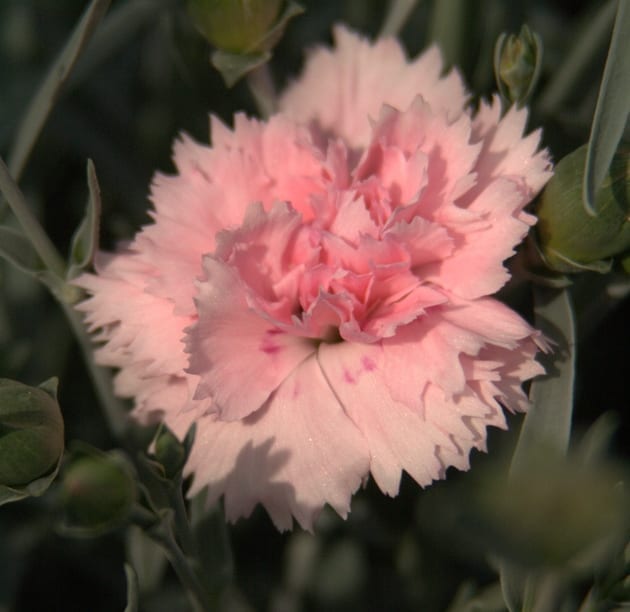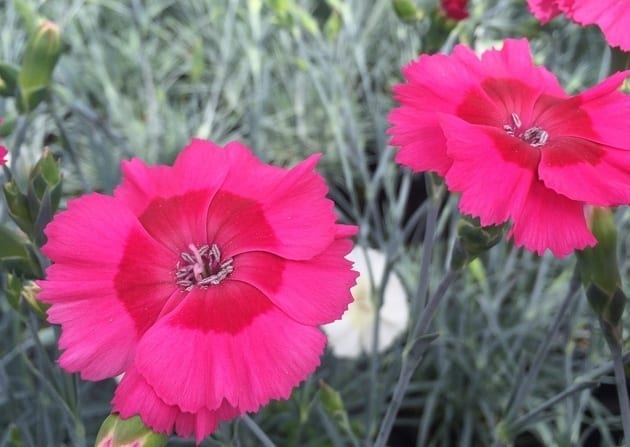Dianthus is a large genus that encompasses some 300 different species of flowering plant. Within the genus are annuals, biennials and perennials (some of which are short-lived) with common names including ‘Pink’; ‘Carnation’ and ‘Sweet William’. They are long-running favourites of the British garden. Plant perennial varieties at the front of a sunny border, or as attractive mounds within rock gardens and containers. They are also loved by pollinators, many having a sweet fragrance and make great cutting flowers.
View our collection of plantsDianthus Varieties
There are a huge number of attractive varieties to choose from. We highlight a number of favourites, grown by our own Hillier Nurseries in Hampshire.
Dianthus ‘Candy Floss’ Pink ‘Candy Floss’
 Dianthus ‘Candy Floss’ is a highly perfumed variety with grey-green foliage and sugar-pink double flowers throughout summer.
Dianthus ‘Candy Floss’ is a highly perfumed variety with grey-green foliage and sugar-pink double flowers throughout summer.
Flowering time: May to August
Sun Requirements: Full sun to dappled shade
Soil: Any moist, well-drained soil
Hardiness: Frost hardy
Size: Grows to 30cm height x 30cm spread
Dianthus ‘Cosmopolitan’ Pink ‘Cosmopolitan’

‘Cosmopolitan’ is a mound-forming, evergreen perennial with grey-green foliage. It produces graceful clouds of vivid magenta, fragrant flowers throughout summer.
Flowering time: May to October
Sun Requirements: Full sun to dappled shade
Soil: Any moist, well-drained soil
Hardiness: Frost hardy
Size: Grows to 35cm height x 30cm spread
Dianthus ‘Memories’ Pink ‘Memories’
 Dianthus ‘Memories’ is a compact, mound-forming, evergreen perennial. It produces pure white, double flowers with serrated edged petals and has a spicy, fruity fragrance.
Dianthus ‘Memories’ is a compact, mound-forming, evergreen perennial. It produces pure white, double flowers with serrated edged petals and has a spicy, fruity fragrance.
Flowering time: May to September
Sun Requirements: Full sun to dappled shade
Soil: Any moist, well-drained soil
Hardiness: Frost hardy
Size: Grows to 25cm height x 25cm spread
Dianthus Growing Guide
They should be grown in well-drained soil in a sunny spot, or with very light dappled shade. For best flowering, prepare the soil in advance incorporating a good multi-purpose compost or plenty of well-rotted manure.
Plant Care Deadheading
Deadhead regularly to prolong flowering. Remove the whole flowering stem and not just the finished flower.
Dianthus Planting Ideas
They are compact, mound-forming plants that work fantastically well at the front of a sunny border where they create a row of colour – the perfect complement to taller, more architectural plants behind.  You can also plant Dianthus simply in containers, for a pot bursting full of colour all summer long.
You can also plant Dianthus simply in containers, for a pot bursting full of colour all summer long.
Fact
The name ‘Dianthus’ means ‘divine flower’ or ‘flower of Zeus’ in Greek – ‘divine’ (dios) ‘flower’ (anthos).”





